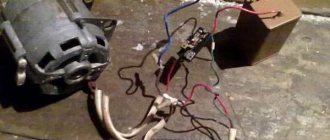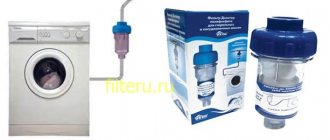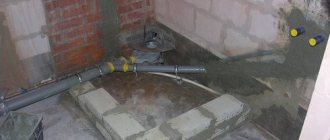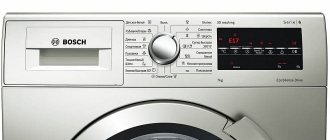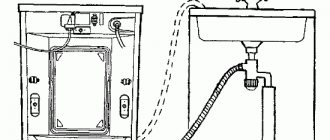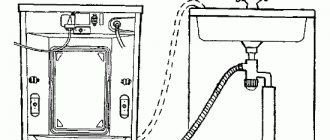When purchasing any household appliance, a logical question arises: “How to choose a place for a new purchase?” And if it comes to a washing machine, then the task becomes much more complicated, because this unit has impressive parameters. And besides, bathrooms often have a small area, which does not allow placing an additional device there. Therefore, it is very common to place a built-in washing machine in the kitchen, where you can experiment with space-saving options.
Location of the washing machine in the kitchen.
Pros and cons of placing a washing machine in the kitchen
In order to maximize space savings, most often the washing machine in the kitchen is built into a cabinet, under the worktop. But it is important to note that this work should be carried out at the time of installing all the furniture in the kitchen, since otherwise it is unlikely that it will be possible to achieve an aesthetic appearance of the entire facade.
The location of the washing machine in the kitchen cabinet.
Often such equipment is placed separately from the kitchen unit, but this is only possible if there is a large amount of free space. A much more convenient option is one with a built-in washing machine, the surface of which is convenient for organizing the countertop.
This type of installation has many advantages:
- Significant space savings, especially if there is not enough space in the bathroom to install the unit;
- Based on fire safety rules, it is not recommended to install any household appliances in rooms with high humidity, which includes the bathroom;
- The built-in washing machine transmits a much lower level of vibration, which is good news.
Washing machine built into the kitchen unit.
Installation and placement of the washing machine. But in addition to the listed advantages, there are also some disadvantages, which for many are the determining factor:
- It is not possible to store dirty laundry in the washing machine, since an unpleasant odor immediately appears, which is very noticeable in the kitchen;
- It is inconvenient to load laundry into built-in appliances, since the door cannot always be opened completely;
- Washing powder can end up on the kitchen counter, food, and other inappropriate places, so you need to be careful.
Built-in washing machine in the kitchen.
How to install a washing machine on a wooden floor
As mentioned earlier, if the floor covering is uneven, simply twisting the legs is not enough, since the device will still deteriorate with each wash. It is impossible to ignore the unevenness of the surface, since the vibration from the washing machine, which occurs when spinning clothes, can worsen the condition of the floor and ruin your nerves - and this is already a serious problem. Moreover, after 2-6 weeks it is quite possible that the device may break down, which is quite expensive for the owner of the washing machine.
The vibration that appears during spinning is a destructive force, which, if installed incorrectly, negatively affects the parts of the device, gradually leading to their failure. If the floor under the washer is level, the vibration will be dampened slightly - in this case, the operating life of the device will increase by 2 times. And if you install the device in a house where the wooden floor is shaky, this will lead to strong jumps in the device, and it will also sway a lot during the spin cycle.
When trying to get rid of strong vibration, washing machine users make many mistakes, which ultimately lead to premature failure of the device.
Mistakes that are made when installing household appliances:
- Before installing the device on the boards, many people lay down a thick mat that reduces vibration. But there is no need to do this, since it will not be able to dampen the force of vibration - this will only lead to a decrease in the strength of the sound that appears during the spin cycle.
- The second, no less common mistake is strengthening the floor with metal corners or pipes. There is no need to do this, since after just 3 months the device will loosen the boards, which will again cause a problem for the owner of the device.
- To quickly level a wooden floor, some owners lay a large concrete slab weighing at least 150 kg. Thus, washing machine owners believe that it will reduce vibration and level out uneven floors. But to achieve this, the slab must have a diameter of at least 2 square meters. Otherwise, the device will rock the stove during spinning, which will negatively affect the wooden surface and the operation of household appliances.
- Some craftsmen try to attach the legs of the washing machine using self-tapping screws directly to the boards. Doing this is prohibited, since vibration will still cause the device to sway and jump, which will cause a strong cracking of the floor and a rumble. In addition, the device can easily break the boards over time, which will require a complete replacement of the coating.
To summarize, it can be noted that before installing the device, it is imperative to level the surface in order to avoid breakages and deterioration in the quality of the floor covering in the future.
Choosing the right machine "Automatic"
There are two main types of Automatic machines:
- Front loading;
- Top loading.
Top-loading washing machines cannot be installed in undercounter cabinets. But they are much narrower, so such machines can be installed separately from the furniture.
Functional washing machine in the kitchen.
Front-loading machines are more in demand, although they are much larger than the previous type.
There are many models of washing machines. The technical characteristics of each type depend on the permissible weight of the loaded laundry and speed. Also, an important characteristic of each model is its manufacturer. Therefore, you should pay attention to this when purchasing.
Each of the models has certain dimensions. Therefore, before purchasing, you need to find out the parameters acceptable for a particular kitchen set:
- The height of the machine must completely coincide with the height of the kitchen furniture;
- The depth of the cabinet, but there should not be any difficulties here, since the machines are usually narrower.
Placing a washing machine in the kitchen interior.
Very often, when choosing a model, attention is paid to the level of noise emitted by the unit, as well as the amount of energy consumed.
Accommodation options
Washing machine in the kitchen interior.
The choice of location for the washing machine must be approached with the utmost seriousness. The result should be not only beautiful, but also convenient and practical.
Let's look at the most popular options:
- If you have a very small kitchen, the washing machine is placed under the sink. This is very convenient, since the water supply network runs very close and no additional pipe laying is required;
- There is an option to place equipment next to the sink. It's also quite convenient. Moreover, if a dishwasher is supposed to be installed in the kitchen;
- A convenient place to install the Automatic machine is a cabinet under the kitchen table.
Built-in kitchen appliances.
Successful methods of device camouflage
It is almost impossible to disguise a top-loading machine as furniture, but a model with a front door is much more convenient to install in the kitchen.
A suitable place in the kitchen for the machine.
Let's consider all the options:
- The kitchen set is ordered according to pre-made measurements of all equipment: washing machine, hood, dishwasher;
- Specialists independently manufacture and assemble furniture along with kitchen appliances;
- You can camouflage the washing machine separately with a countertop or door.
Examples of built-in appliances in the kitchen.
You can also install a washing machine yourself into the kitchen wall in various places. This will take more time, but it will be an opportunity to save money.
Main stages of installation
Before installing the device, you need to evaluate the room. Perhaps the installation will become impractical and it is worth taking a closer look at the hanging model, which is located in a small space. To save square meters, the machine can be installed in a box or corner. Placing it close to utilities minimizes the likelihood of pump overload , so it is better to install the equipment near the sink.
An important point during installation is to take into account that the equipment will vibrate when spinning or when the drum is not fully loaded, so the floor in the kitchen must be level. This drawback can also be eliminated by adjusting the legs and additional fastening. It is necessary to leave a gap of 2 cm between the equipment and the wall. Basic installation rules:
- The device is closed with a door only at the front, and left open at the back to improve air circulation.
- They are installed on a cabinet separate from the cabinet or ensure stability on the cabinet base.
- It is not recommended to place electrical appliances and kitchen utensils on the washing machine.
Sometimes difficulties arise with placing equipment in standard headsets, but this problem can be solved by ordering equipment or a custom-made headset. If the color of the facade of the set and household appliances is different, then to create visual unity they are covered with film or painted.
Preparing for installation: necessary tools and materials
Kitchen interior design with washing machine.
Installing a washing machine in a kitchen built under a countertop requires the following materials and tools:
- Special elements used to fasten the unit;
- Pliers and a sharp knife;
- Adjustable wrench;
- Screwdriver indicator;
- Level for construction work required to install the machine in a level position;
- Water filter;
- Shut-off valve;
- Hose for supplying water to the machine;
- Special sealing tape.
Washing machine in the kitchen interior, types and installation.
Once everything you need has been prepared, you can proceed to the actual installation of appliances in the kitchen.
Where to start installing a washing machine
The built-in machine has been purchased, the table top with a niche has been made, it’s time to start preparing for installation. First of all, we will collect all the necessary tools and components to connect the machine with electrical and plumbing communications, we will need:
- necessary fasteners;
- a set of keys of different sizes and an adjustable wrench;
- pliers;
- laser or regular tape measure;
- household level;
- sealing tape and automotive sealant;
- screwdriver and ammeter;
- water hoses and filters of suitable diameter;
- crimp coupling or tee;
- special shut-off valve;
- sharp knife.
When preparing to install a built-in machine with a removable lid, you must carefully read the instructions that come with it. Most likely, the manufacturer has already prescribed some nuances of its installation in order to avoid mistakes on your part.
It is especially important to understand how to connect the machine to electrical communications, so no amateur work - follow the manufacturer’s instructions.
The immediate process of installing the unit
Washing machine in the kitchen, styles and types.
Now you need to install a washing machine in the kitchen. Very carefully, trying not to damage the kitchen furniture, you need to install the unit under the countertop. Sometimes some problems may arise here.
For example, such as:
- The compartment for adding powder in the washing machine does not open;
- Possibility of partial opening of the door to load laundry.
To solve these problems, you can try to push the machine further into the closet. Now it’s time to start installing the door.
Drawing of a built-in washing machine.
But a built-in Automatic washing machine in the kitchen requires more than just proper installation. It still needs to be connected.
Operating principle of stands
The operating principle is very simple. Since plastic and rubber have increased elastic forces and relatively low density, the steel legs of the washing machine literally bite into the material, thereby extinguishing energy.
The opposite situation. When the washing machine is on a dense surface, the energy that comes from the rotation of the drum is transferred to the legs, which are repelled from the floor covering. This creates the effect of a jumping washing machine.
You can also find out on the website how to choose a washer and dryer.
Connecting to communication networks
Connecting a washing machine in the kitchen.
The washing machine in the kitchen requires connection to the sewer and water supply network.
Connecting the washing machine to the sewer must take into account the following nuances:
- To connect the washing machine directly to the sewer network, you will need an additional siphon. The hose connected to the machine is properly connected to the drain directed from the sink in the kitchen. Such a connection completely eliminates the possibility of leakage;
- You can attach the drain directly to the side of the kitchen sink, but this option is not reliable and safe;
- The best option for connecting washing equipment to the sewer network is to install a drain in the kitchen, specifically designed only for these purposes;
- After installing the unit, you should pay attention to the pipe - it must be in a fully straightened state. Then it needs to be secured, while making sure there are no kinks. If it is necessary to lengthen this element, it is worth installing specially designed clamps as a fastening system.
Washing machine in kitchen design.
Now you can start connecting the Automatic machine to the water supply network. To do this you will need to do the following:
- Before starting work, you must purchase flexible hoses with a diameter of ¾ inches;
- It is necessary to install a valve to the water pipe, which is usually closed after each washing procedure;
- For an uninterrupted supply of water to the washing machine, you can use outlets in the form of tees or pipes directed from the mixer located in the kitchen. This outlet is attached to the water supply, washing machine and pipe extending from the mixer;
- When making all fastenings, you should use a special FUM tape or tow.
Space in the kitchen for a washing machine.
At this point, the under-counter washing machine is considered fully installed and connected. You can safely start using it.
Features of repair and replacement of fasteners
All installation work on connecting water must be carried out with the supply to the apartment (house) shut off. There is an inlet tap in most residential premises. Where it is absent, a cut-off is made for the entire riser or in the well.
No repair work can be carried out while the machine is plugged in.
When going for new door mounting parts, you should take the old unit with you. Even on machines of the same type from different series, discrepancies occur. Sometimes it’s millimeters, but it’s impossible to replace it.
When repairing a drum or door, you need to check, at least superficially, the remaining components, open and clean the pump filter, and check the heating element for scale.
Installation, connection, fastening and ongoing minor repairs of components can be done even by a not very experienced person. As a rule, all it takes is a wrench, a screwdriver and some care. Here, as elsewhere, it is important not to overestimate your strength. If the breakdown is obviously related to the electrical part or electronics, it is better to seek the services of a specialist.
Did you manage to solve your problem using the recommendations from the article?
Yes!
46.57%
No. More answers required. I'll ask in the comments now.
37.79%
Partially. There are still questions. I'll write in the comments now.
15.64%
Voted: 569
Final details
To minimize the vibration of the washing machine during operation, it is necessary to install it absolutely level in place. For this purpose, the machine is equipped with special adjustable legs. In their absence, rubber bands with a thicker structure are usually used.
Installing a washing machine in the kitchen.
Now you can check the stability of the washing machine by leaning all your weight on the device. Even with a slight swing, it’s worth starting all over again. A water level will help in this rather difficult task. It is important that in the end, the washing equipment stands in a perfectly level position.
Stable location of the machine in the kitchen.
A washing machine installed in the kitchen saves significant space, especially if it is built into a cabinet covered by a door. Thus, there is no need to select equipment for the headset, or vice versa. The main thing is that the parameters are combined, and the installation is successful, without any problems or damage.
Reasons for the spontaneous movement of large household appliances
The main reason for a washing machine to move is vibration. The fact is that during the rotation of the drum with laundry, a centrifugal force arises, which is transmitted to the body of the device. Most of it is damped by a counterweight and a shock absorber system with springs. If the engine is turned on at maximum speed, and the laundry is distributed unevenly inside the drum, the vibrations cannot be completely suppressed.
Most often, narrow models “walk”. Manufacturers, trying to reduce the size and weight of the device, install excessively light counterweights inside. Their inertia is not enough to stabilize the drum during spinning. At the same time, in other modes the body is completely motionless.
If you notice that a recently purchased device moves on its own, the cause of the movement may be improper installation. Often it is enough to simply level the case, and the problem will go away by itself.
Of course, damage to one or more units of the washing machine cannot be ruled out. The reasons for vibration can be different, for example:
- the shock absorber has failed;
- one or more springs have burst;
- the counterweight fastening has become loose;
- The drum bearing is broken.
If any of the above malfunctions occur, you must immediately take all possible measures to securely fix the washing machine. Strong vibration is fraught with consequences. It not only contributes to the “walking” of the washing machine, but can also lead to the failure of a number of its expensive parts.
